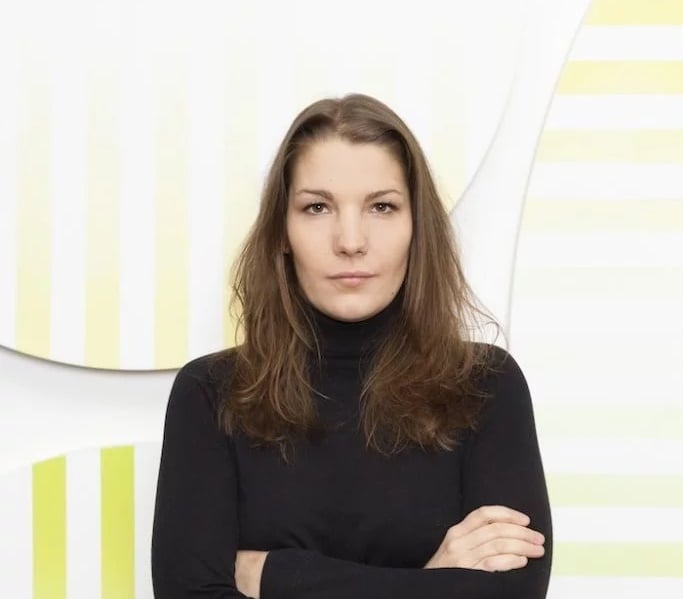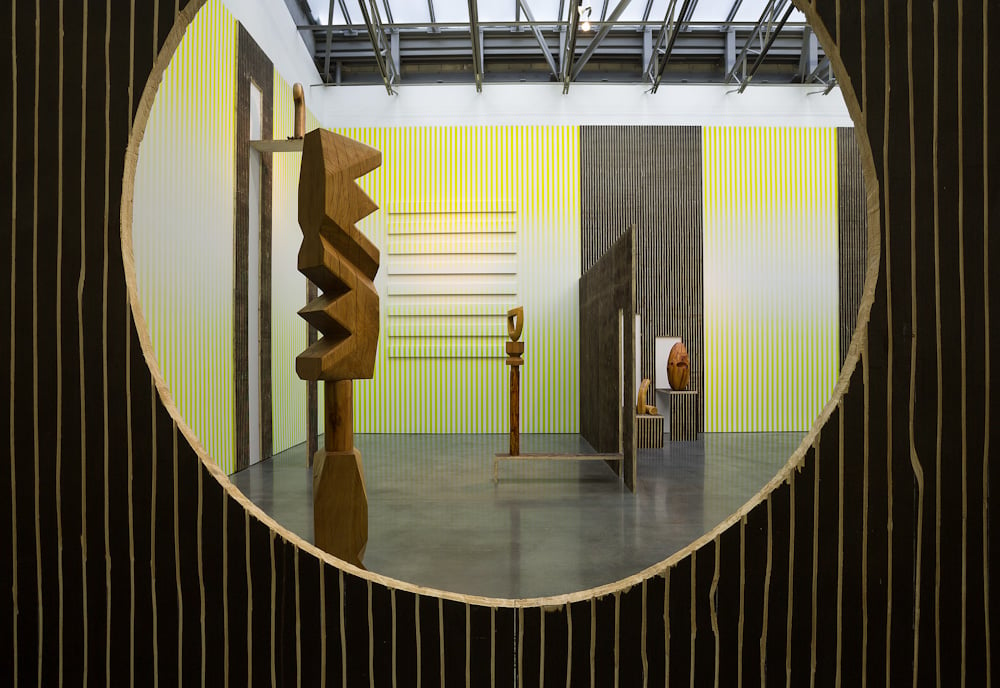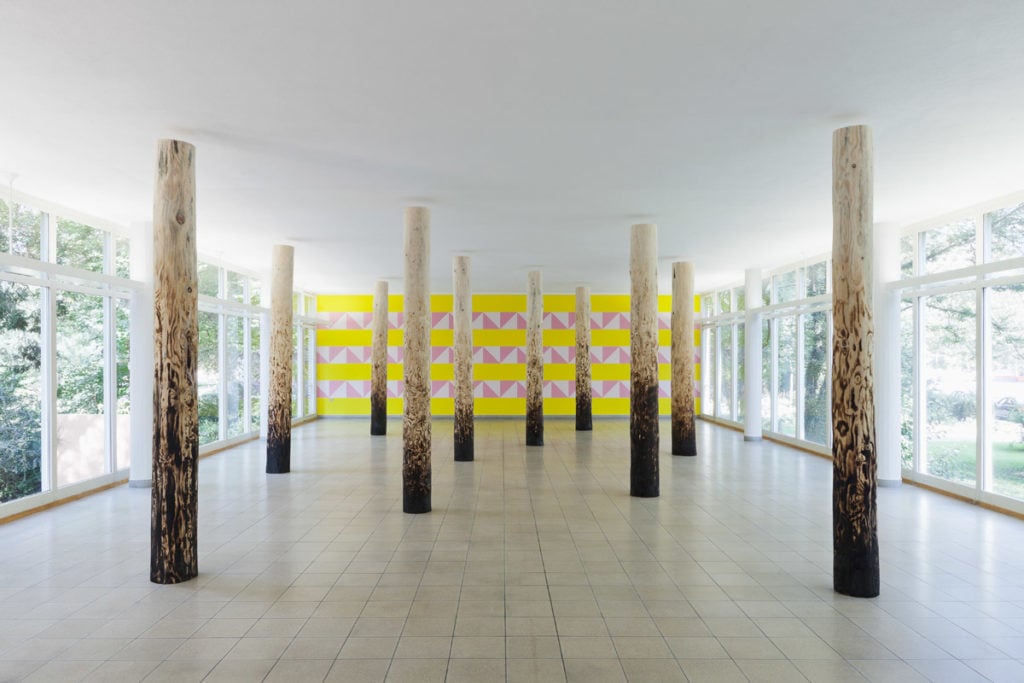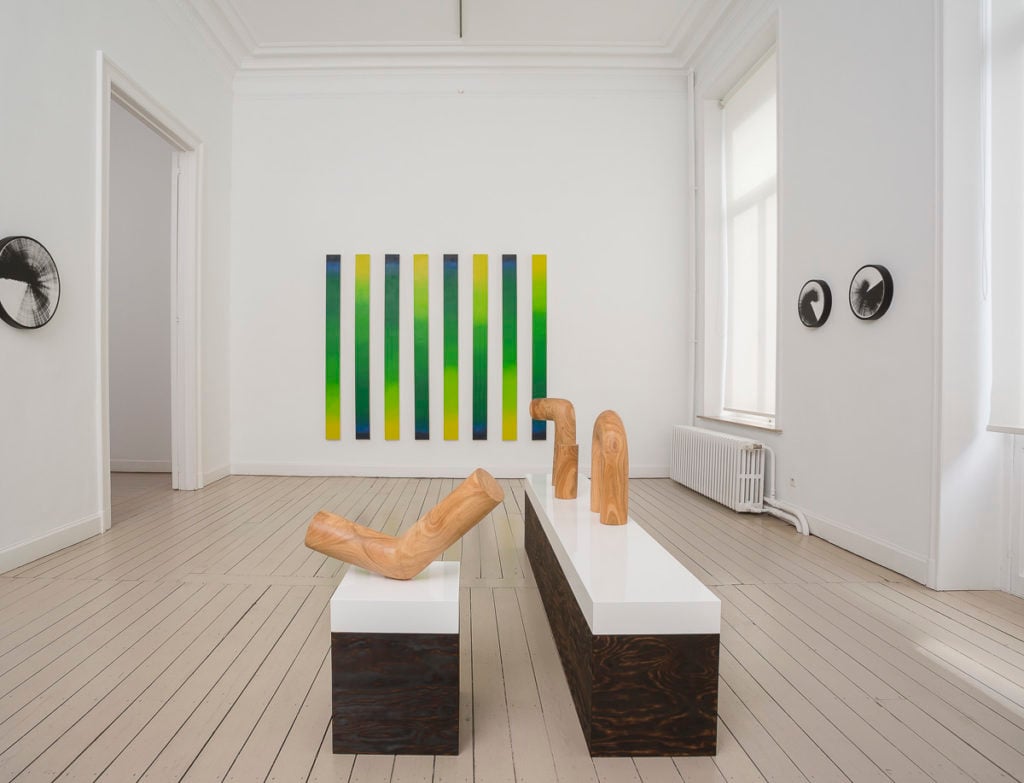People
How Sculptor Claudia Comte Used a Chainsaw to Carve Out a Buzzing Career
The rising star's playful works have the art world taking her very seriously.

The rising star's playful works have the art world taking her very seriously.

Louisa Elderton

One reason that the rising-star sculptor Claudia Comte has managed to captivate so many of the world’s top collectors, curators, and dealers in so short a span of time may be because almost everything about her is a paradox. She works with a chainsaw… to make wooden sculptures of exceptional delicacy and refinement that recall such Modern greats as Constantin Brâncusi and Isamu Noguchi. She displays her works, heartfelt anachronisms, in immersive installations replete with googly eyes, zany stripes, and other Instagram-ready memes. She lives in Berlin and is a habitué of the city’s hard-partying club scene, but she calls herself a “country girl at heart,” owing to her upbringing in the idyllic Swiss town of Grancy in the Jura Mountains, where she still sources the wood for her sculptures.
Another paradox? This month, for her highest-profile installation to date—in Art Basel’s Messeplatz, the heavily-trafficked nexus of the art world’s premier market event—Comte has chosen to complement this exceedingly refined setting by presenting the most vernacular of formats: a carnival.
Titled NOW I WON and echoing the actual Carnival of Basel that pops up each year for exactly 72 hours, the installation invites visitors to wander through seven booths (each of which has been hand carved by the artist with a chainsaw) and participate in drinking games, arm-wrestling, dance-offs, bowling games, mini-golf, ball-tosses, and darts—only with her circular abstract paintings for the targets, and her smallest chainsaw-carved sculptures to date acting as bowling pins. Over the course of the fair, three lucky winners will walk away with sculptures that Comte has hewn from Arabescato Carrara marble to serve as prizes: a cactus for first place, a snake for second, and a donut for third. (Each is worth between €22,000 [$28,000] and €36,000 [$46,000].)
Overseen by the curator Chus Martinez, the installation is by far Comte’s largest work to date, and anyone hoping to play along has to pay an entrance fee of three francs (the proceeds of which go to the Swiss environmental organization Pro Natura).
“My galleries were saying, ‘Ah, but we could give some tickets to the VIPs,’ and I said, ‘No way, everyone has to pay the same amount.’ It’s not about creating different categories,” says Comte, who believes her project has the democratic potential to reach audiences outside of the cloistered art world, especially people who aren’t particularly interested in art but who might just be passing by the fair. In other words, it’s for the everyman. “For me, the work is about bringing people together,” she says. “It’s not a critique of the art world—it’s more playful in intention, allowing us to see and engage with an art installation that embraces all of the senses. It’s really meant to be taken with a wink of the eye.”
At 33, Comte is known for her killer work ethic—it’s how she got where she is today—but she’s also open and friendly, with an endearing laugh that peppers her conversation. Growing up away from the bright lights of the big city, Comte was raised by a practical family: her grandfather was a cheese maker, her father an engineer, and her mother worked as a secretary before dedicating herself to raising Comte and her two older brothers. Surrounded by nature and forest living, she didn’t really learn about art until university, and even then she studied educational pedagogy as a means of teaching art to children between the ages of 10 and 18.
“When I’m at my parents’ place near the farmers and lumberjacks, when I speak about this world it feels very far from their world,” Comte says of her chosen profession. “Sometimes I feel the art world is too elitist. It’s really important for me to do a work that can be read on lots of different levels, and that’s what I’m trying to do with the funfair on Messeplatz.”

Installation view of Claudia Comte’s “NO MELON NO LEMON” at Gladstone Gallery, 2015. Image courtesy of Gladstone Gallery, NY König Galerie, Berlin.
If the art world is elitist, Comte has certainly been making headway into her generation’s own art elite in the past few years. She got her big break when the curator Neville Wakefield included her in a group show at Chelsea’s Barbara Gladstone Gallery in 2013. Later that year she received a solo show at Gladsone’s Brussels outpost, and when she followed it up with a vibrantly cheeky 2015 solo show in Chelsea—at which point she was the gallery’s youngest artist—she earned the endorsement of powerful New York Times critic Roberta Smith, who encouraged her readers to “enjoy the impertinent mood, take selfies.”
Comte still recalls the review with surprise: “When the gallery heard that Roberta Smith would write they said, ‘Well, look, she never writes good things, because her and Barbara are really not good friends, just so you know.’ So when it came out, everyone at the gallery was really happy!”
From then on, Comte’s ascendant career led her to a nonstop string of exhibitions at such locales as Kunstmuseum Luzern, SALTS, and this year’s Desert X in Palm Springs (also curated by Neville Wakefield), where her freestanding Curves and Zigzags was among the most-Instagrammed works. Recently, MoMA acquired one of her woodcut prints.
Gladstone, meanwhile, is supporting her installation at Art Basel. “We’ve always been drawn to the ways Claudia’s work makes the viewer rethink space and how art can be seen in a variety of contexts,” says Gladstone director Laurence Dujardyn. “Her practice creates a universe of its own, imposing a certain order and logic while always allowing in a human, more imperfect aspect.”
Based in Berlin, Comte today makes her artworks in a 3,000-square-foot studio in a former elevator-assembly plant in Pankow, a neighborhood formerly part of East Berlin. She splits her space into two parts, one for painting and one for sculpture. “I also have a courtyard where I can use the chainsaw and do the polishing if it’s not too cold outside,” she adds. “It’s my dream studio, actually.”
As for the chainsaw? Comte first used one to sculpt logs while she was at the École cantonale d’art de Lausanne, carving tree trunks into rough curvilinear forms or zigzagging shapes—a process that has since become increasingly refined over the years, with stages of sanding and polishing to enable a smooth finish. She sources her materials from the forests near her hometown “because I know people in the forest there,” she says, deliberately choosing wood—ranging from walnut and pine to cherry and ebony—from trees that have been felled for ecological reasons.

Installation view of “Many Kinds of Suspense Pictures” 2012, Kunsthaus Glarus, Switzerland. Photo: Gunnar Mier courtesy of Gladstone Gallery, NY and König Galerie, Berlin.
Comte has recently also translated her sculpting process into pristine marble, scanning her finished wooden forms to be carved via a machine-milling process in Carrara, Italy. Her paintings, meanwhile, typically feature graduated planes of color or monotone lines on shaped canvases, and she likes to hang them atop walls that she has painted with angular patterns to recall Op Art.
Currently, her smallest paintings start at $4,500, with her largest sculptures going for around $90,000; wooden sculptures of the kind Gladstone is exhibiting at Art Basel this year typically sell for between $17,000 and $22,000. “I like to know in advance who is interested, and to get some information” about prospective collectors, Comte says. “I have a very intimate connection with my paintings and sculptures, since they are very physical to produce. I consider them like my babies, so I like to know where they go.”

Installation view of Claudia Comte’s “Wir baden auf der Freianlage,” 2013. Image courtesy of Gladstone Gallery, NY and König Galerie, Berlin.
In Europe, Comte’s expanding market is being spearheaded by her hard-living Berlin dealer Johann König, who held a recent after-party at the notorious nightclub Berghain. But while she loves the nightlife, she has lately toned down her own excesses as her career has taken hold.
“I used to party so much and drink too much, but when I turned 30 I thought, ‘Okay, now I’m going to die if I continue like this.’ I stopped drinking and can only recommend it. You feel a change after the third month; I feel so much more clear in my mind and much stronger.” (She’s still a regular at Berghain and the Kit Kat Club, a techno set with a fetish dress code, calling a night spent hopping from one to the other “a perfect mix, actually.”) Often accompanying Comte on her escapades is her longtime boyfriend Samuel Leuenberger, the curator of SALTS and also Art Basel’s Parcours section.
For Comte, her work is a way to get people to take things less seriously—while, at the same time, taking other things more seriously. “Art makes you think,” she says. “Too many people are watching TV and not thinking for themselves. That’s the most important thing in the world, alongside education and taking care of our planet. It’s so important to open that for everyone. It’s such a pity what’s happening in the UK and in America right now, with Trump—it’s so depressing. I want to provide joy through my art.”